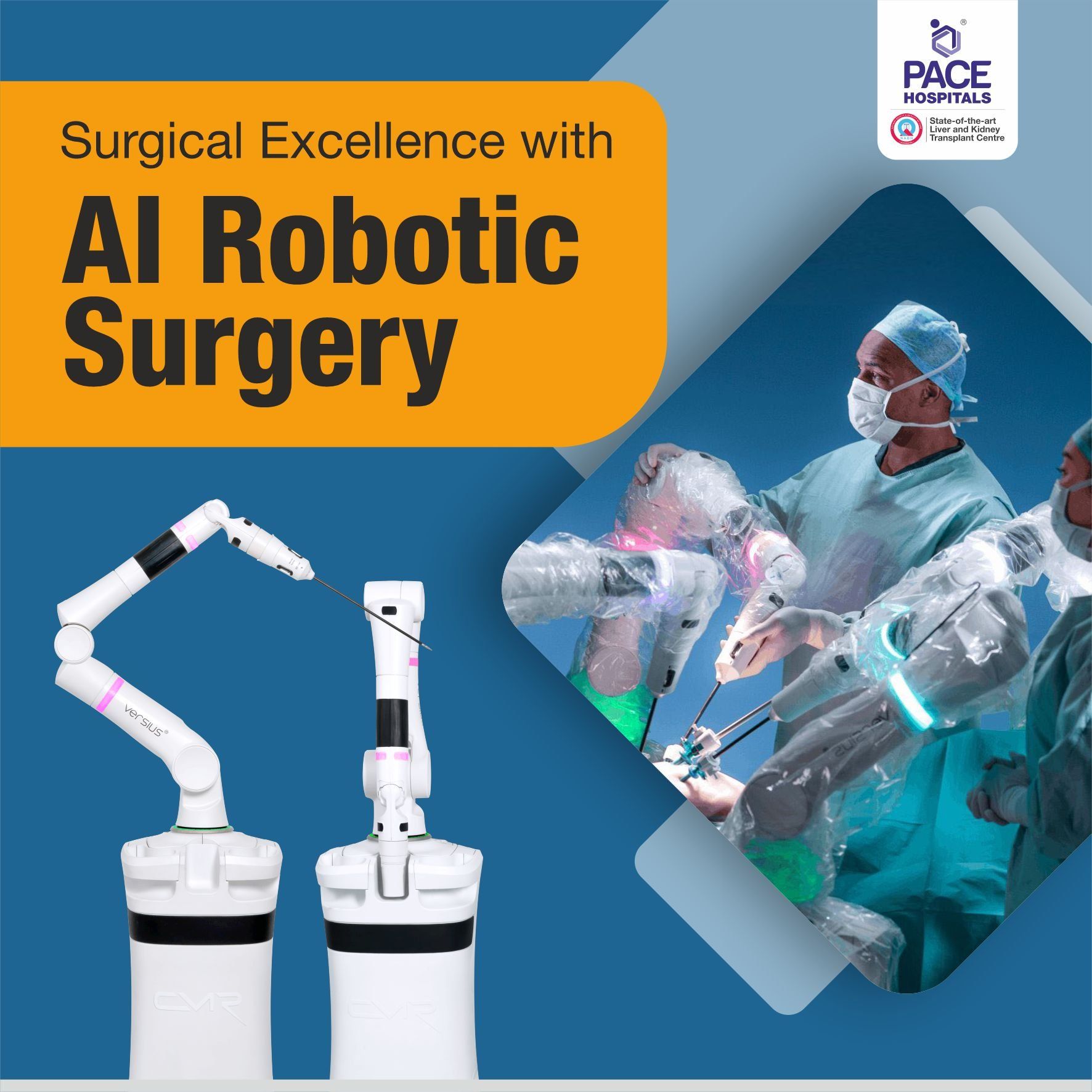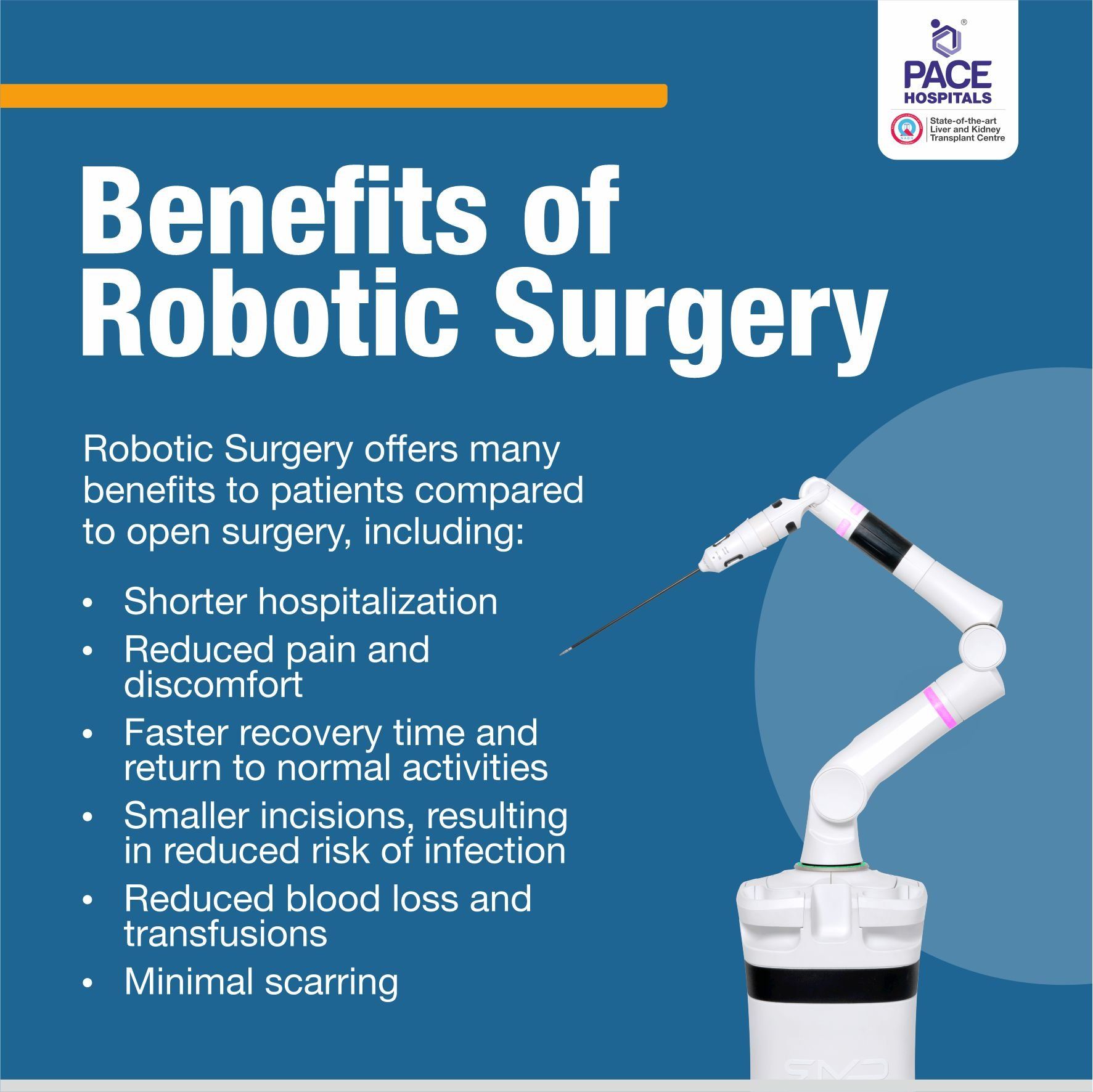Robotic Surgery Hospitals in Hyderabad, India | Cost and Benefits
At Pace Hospitals, dept. of minimally invasive surgery equipped with the World’s First AI Universal Surgical Robotic System.
The HD 3D Vision AI Surgical Robotic System provides dexterity, precision and control for the complex and oncological procedures related to Gastroenterology, Colorectal & Upper GI Procedures, General Surgery, Bariatric, Gynaecology, Urology and Thoracic Surgeries.
What is Robotic Surgery?
Robotic surgery is a type of minimally invasive or laparoscopic (small incision) surgery in which doctors utilize a computer-controlled robot to help them with specific surgical procedures. The robot's "hands" have a great degree of dexterity, allowing surgeons to operate in very small areas in the body that would typically require open (long incision) surgery.
Robotic and minimally invasive surgery has smaller incisions than open surgery (conventional surgery with incisions), resulting in less discomfort and scars.
Using robotic technology, surgeons can execute difficult surgical procedures through small incisions. Surgical robots are self-powered, computer-controlled machines that can be trained to assist with surgical tool positioning and manipulation. Surgical accuracy and flexibility are improved as a result.
Benefits of Robotic Surgery
Two-dimensional imaging, restricted functional mobility of the instruments, and poor ergonomic posture of the surgeon are some drawbacks of laparoscopic surgery. The robotic surgery system was developed to address laparoscopy's limitations. The benefits of robotic-assisted laparoscopic surgery include better visibility and dexterity. Relative to conventional laparoscopy, this new approach offers undeniable technical benefits. 3D imaging, tremor screening, and articulated instruments are among the features of robotic systems. Because of the enormous increases in vision and control possible with this advanced equipment, robotic surgery outperforms traditional laparoscopic surgery. Robotic systems are being researched more and more for productivity and overall and usability.
As compared to open surgery, robotic surgery has a number of advantages for patients, including:
- Less time in the hospital
- Less pain and suffering
- Quicker recuperation and resumption of routine activities
- Incisions which are smaller, leading to a lower risk of infection
- Minimal scarring and blood loss
The AI Robotic System is meant to let surgeons deliver the benefits of minimal access surgery to patients all through the world. Individually cart-mounted arms let it move between operation theaters, giving your surgical team constant access to patients.
The AI Robotic System allows therapists the freedom of port placement while providing the benefits of compact fully wristed devices by bio-mimicking the human arm. The system also offers 3D HD vision, simple instrument control, and a variety of ergonomic working positions, all of which have been created to aid surgeons reduce stress and tiredness and lengthen their careers.
Frequently asked questions:
What is the definition of minimally invasive surgery?
Minimally Invasive Surgery (MIS) has grown in popularity in hospitals around the world. In this operation, the surgeons make a little incision rather than a huge one like in standard open surgeries, and they utilize a variety of techniques to reduce the amount of damage to the body. Because the incisions are small, people recover faster, have less scarring, and experience less pain.
During MIS operation, the surgeon makes small 3/4-inch holes in the skin to pass laparoscopic equipment includes: endoscope, camera, light source, and surgical instruments. The doctor utilizes these devices to carry out the procedure while seeing the images from the camera on the computer.
Minimally invasive surgery is also known as:
- Laparoscopic surgery
- Surgery using a keyhole
- Surgery using a band-aid
What happens if the robot breaks down during procedure?
This would be an once-in-a-lifetime event. The equipment is built to extremely high quality standards and is subjected to a rigorous set of required examinations on a regular basis. Before each surgery, it is also subjected to a series of rigorous and legally mandated inspections. Regardless, the physician and the surgical team are always prepared to convert the surgery to a laparoscopic or open procedure. For example, if a pilot's automatic landing system fails, he or she will have been trained to land the plane manually. As a result, your surgeon should be able to do open, laparoscopic, and robotic procedures.
Is robotic surgery more expensive?
While robotic surgery is slightly more expensive than laparoscopic surgery, the savings are compensated by the lower cost of a shorter hospital stay and a quicker return to work. There are additional intangible benefits such as less or no blood transfusions, less pain with better results, and improved cosmetic results.
Can any doctor perform robotic surgery?
Without proper training any doctor cannot simply perform a robotic surgery. Surgeon should be properly trained they should have previous experience of doing laparoscopic minimally invasive surgery.
Is robotic surgery covered by health insurance?
Robotic surgery is a type of minimally invasive surgery that uses a robot. Robotic surgery is normally covered by any insurer that offers minimally invasive surgery. It's crucial to remember, however, that your coverage will be determined by your plan and package benefits. Prior to your surgery, you should check with your insurance company for specific information.
Why does robotic surgery take longer time?
Because of the enhanced images, the surgeon can view the surgery site more clearly, which could improve precision. Robotic surgery, on the other hand, may take longer to complete than traditional laparoscopic surgery. Infection, hemorrhage, and anesthesia-related reactions are still a possibility.
What is the cost / price of robotic surgery in India?
Robotic Surgery cost in India ranges vary from Rs. 1,70,000 to Rs. 4,75,000 (one lakh seventy thousand to four lakh seventy-five thousand). However, price of robotic surgery in India depends upon the multiple factors such as hospital, type of surgery, room selection and insurance for cashless benefits.
Robotic Surgery cost in Hyderabad ranges vary from Rs. 1,85,000 to Rs. 3,75,000 (one lakh eighty-five thousand to three lakh seventy-five thousand). However, price of Robotic Surgery in Hyderabad depends upon the multiple factors such as selection of room for hospital stay, type of surgery and corporate, CGHS, or insurance for cashless treatment.
What is the cost of robotic endometriosis surgery in India?
Robotic endometriosis surgery cost in India ranges vary from Rs. 1,70,000 to Rs. 2,85,000 (one lakh seventy thousand to two lakh eighty-five thousand). However, price of robotic endometriosis excision surgery in India depends upon the multiple factors such as no. of days stay in hospital, patient conditions, size of endometriomas, room selection and insurance for cashless benefits.
Robotic endometriosis surgery average cost in Hyderabad is approximately Rs. 2,35,000 (two lakh thirty-five thousand). However, cost of robotic endometriosis surgery ranges vary from Rs. 1,75,000 to Rs. 2,45,000 (one lakh seventy-five thousand to two lakh forty-five thousand) and depends upon the multiple factors such as selection of room for hospital stay, size of the cyst, patient condition, corporate, CGHS, or insurance for cashless treatment.






